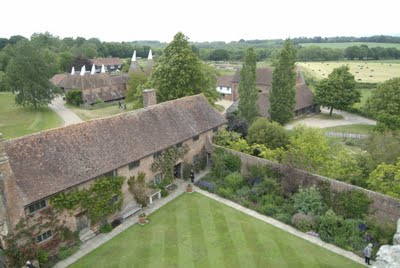Vita Sackville-West and Harold Nicholson's Edwardian English Garden, Sissinghurst.
Sissinghurst is perhaps one of the most beloved gardens in all the world. For many it is the definitive English garden, evoking the poetic sensibilities of its creators, their deep feeling for history and rural tradition and the influence of their aristocratic upbringing and travels.
A labor of love created by Vita Sackville-West (1892-1962) and Harold Nicholson (1886-1968), the garden was planned and built over thirty years beginning in 1932. It is a garden set among a manor house built in the Middle Ages, ancient farm buildings, a moat and a tall Elizabethan tower. Along with Hidcote, it has a formal garden design, yet informal “cottage-style” planting.
Garden historian, author and designer Penelope Hobhouse sees Sissinghurst as the “epitome of English garden traditions – a translation of Edwardian splendor into a personal odyssey.” Much like Hidcote, there was “an integrated architectural framework” of garden rooms, a sequence of spaces, created with hardscaped (pink brick) walls or tall clipped hedges enclosing one area with another adjoining it. The compartmentalization of these color themed “garden rooms” contain axial views, focal points through doorways into gardens beyond. Within each very rigid, geometric enclosure is the contrasting softness of relaxed cottage-style gardening, an influence of Gertrude Jekyll and William Robinson. It is known that Vita treasured Robinson’s “The English Flower Garden” and “The Wild Garden” and visited him in his later years (presumably) seeking his advice.
Much of the fascination behind this garden stems from the family history of Vita as well as her ability to generate public interest in the garden. Sackville-West was a very successful writer on the fringes of the Bloomsbury Group. Along with her novels, short stories and poetry, she was also a garden correspondent for The Observer, where she regularly wrote about her experiences creating the garden, from garden planning to small garden design ideas for the backyard. Additionally she gave garden tours, thus building up the public’s intrigue and fascination. Many might suspect that her inspiration for so many outdoor rooms was a subconscious recreation of a childhood spent at Knole,* the largest private home in England. Knole is known as a calendar house… 365 rooms!
The Roman peristyle garden is considered the first outdoor room and an extension of indoor space. However, Sissinghurst has perhaps more than any other garden influenced future designers to divide a landscape into “rooms”.
Vita was heiress to the Knole estate, however the primogeniture laws in England prevented woman from inheriting property and thus it was (unfairly to her) passed on to a male cousin and eventually the National Trust.
**All photos ©Todd Haiman 2011










